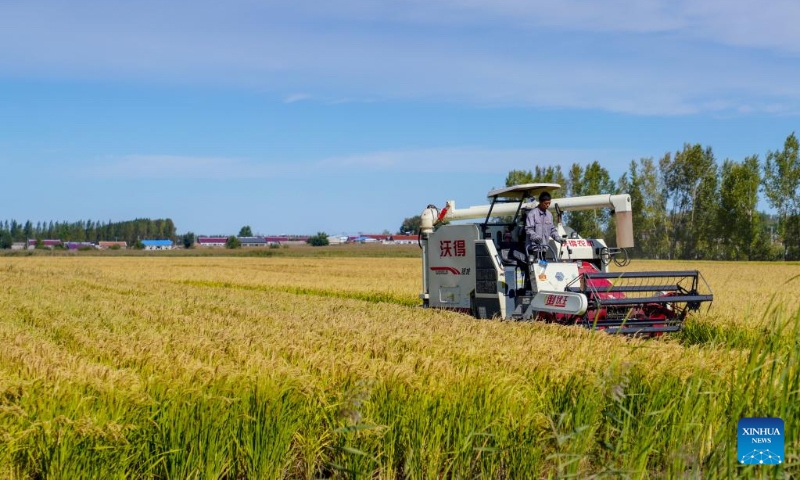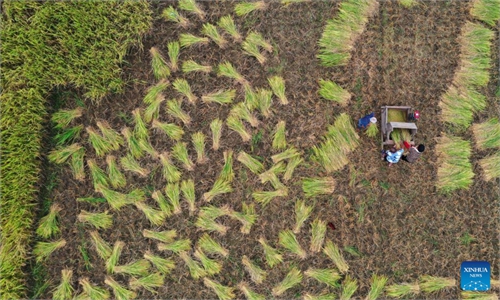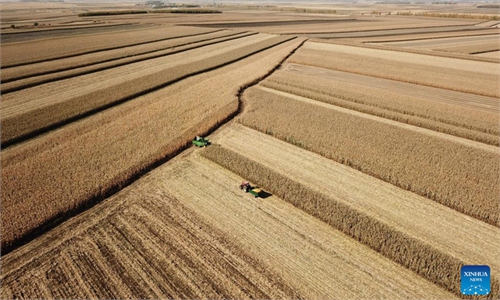
A farmer drives a farming machinery to harvest rice at a family farm in Jiutai District of Changchun, northeast China's Jilin Province, Sept. 20, 2022. Autumn harvest has recently started at the rice-growing areas across the province. Photo: Xinhua
China's total grain output this year exceeded 695.41 million tons, up 1.3 percent year-on-year, thanks to the government's effective efforts to bolster food production, official data showed on Monday.
According to the National Bureau of Statistics (NBS), 2023 is the ninth consecutive year that the grain harvest has surpassed 650 million tons, laying a solid foundation for accelerating the building of a strong agricultural sector, which backs the high-quality development of the country while making a positive contribution to stabilizing the global food market and safeguarding food security.
Moreover, corn output rose 4.2 percent year-on-year, wheat production fell 0.8 percent and rice production shrank 0.9 percent.
Meanwhile, this year's harvest was not easily achieved. It came despite negative weather events, including a prolonged rainy spell in regions along the Yellow and Huaihe rivers, floods in the northern and northeastern regions, and drought in the northwest, NBS official Wang Guirong said.
"This year's increase in grain production has enabled our country to further grip the initiative of food security, while also providing a stabilizer for the improvement of the world's breadbasket," Li Guoxiang, a research fellow at the Chinese Academy of Social Sciences, told the Global Times on Monday.
China has always given top priority to food security. In February, the country issued its No.1 central document for 2023, calling for enhanced efforts to stabilize production and ensure the supply of grain and important agricultural products.
The document is seen as an indicator of policy priorities. Work on agriculture and rural areas has been high on the agenda for 20 consecutive years since 2004, the Xinhua News Agency said.
"This year's bumper grain harvest benefited from the country's institutional advantages. The central government emphasized food security, and local authorities actively assumed responsibilities for expanding the planting area, laying a solid foundation for increased grain production," Li said, noting that higher returns for farmers have boosted their confidence and motivation to farm.
To encourage farmers to grow grain, the central government increased the minimum purchase prices of wheat and rice, and improved grain subsidy policies for corn and soybean farmers in 2023, Wang noted.
As a result, China's grain planting area reached 1.785 billion mu (119 million hectares) in 2023, up 0.5 percent year-on-year.
The soybean sowing area stood at 157 million mu, up 2.2 percent, and the second year that the country has maintained a soybean sowing area of more than 150 million mu.
Of the 31 provincial-level regions, 27 increased their grain output. Northwest China's Xinjiang Uygur Autonomous Region boosted its grain output by 30.55 million tons from 2022 by adjusting the planting structure and optimizing the allocation of water resources.
The rising soybean output this year highlights the country's determination to increase its soybean self-sufficiency rate. In 2023, China's soybean production totaled 41.68 billion jin 205.43 million tons, up 2.8 percent year-on-year.
"The increase in soybean production and planting areas are major highlights of this year's bumper grain harvest. China's soybean output has maintained growth momentum this year, which is of great significance in improving the structure of our grain supply and demand and meeting the upgraded needs of consumers," Li noted.
Wang noted that this year's harvest coincides with the country's efforts to increase the per-unit yields of major crops and improve technological support for crop cultivation.
The country's grain yield per unit area increased 0.8 percent year-on-year. The increased yield contributed 58.7 percent of the rise in grain production, NBS data showed.



